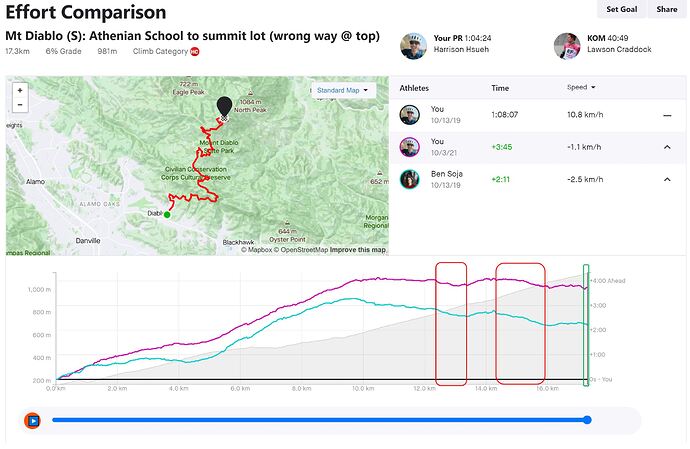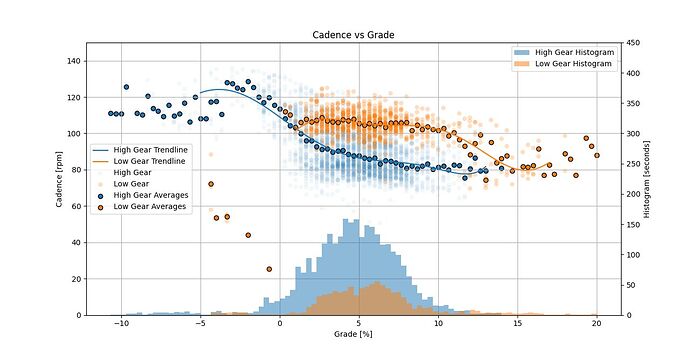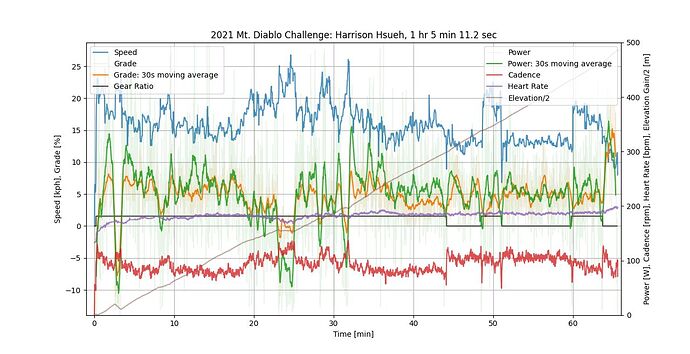You’re leaving out the inefficiency of the wobble. Unicycles don’t travel in a straight line; they wobble around their axis with every pedal stroke. (This is also true of bicycles but to a much lesser degree). That wobble increases both the effective distance traveled, and the translation of power input into forward momentum.
The only mechanical “reasoning” was related to machines, not human bodies. The reasoning provided is not evidence so please do not judge it’s quality. It’s just an opinion based on personal experience and observation, like everyone else.
Spend enough and bikes are lighter than a uni. My 29" comes in at 8.5 kg, that’s heavier than many bikes. A few Kg here and there is not part of these discussions, it just too many pies.
Not an advantage either.
Yes, that is true. Handlebars help with this, but is definitely a disadvantage. However, wouldn’t a squiggly line just mean a unicyclists rides at a slightly lower effective gradient? This would increase rolling distance and rolling resistance per straight distance covered, but at about 10W of rolling resistance for good tires, 5% increase of rolling distance and thus rolling resistance losses is quite small. 0.5W?
The resistance per squiggly traveled distance should be very similar to resistance per straight distance. The rolling resistanve coefficient may be a few percent more as the tire takes more sideways loads, but even so, I think it’s tiny.
Lightly squiggly movement could change aerodynamics too, but we are currently quite slow on unicycles it really shouldn’t matter either.
Don’t know how squiggly riding’s effect can be quantified, but maybe it’s possible?
Forgot to mention momentum. I don’t think it’s an issue, like I said it’s like going up a lightly lower gradient. The squiggly path will have a bit more rolling resistance, but I don’t think it’s much. For example, a bicycle making a turn on a smooth surface doesn’t loose much more speed than if it were to coast going straight. If the squiggliness is just a few degrees at maximum, I don’t think there’s much loss. Cornering rolling resistance on thin bicycle/unicycle tires… maybe there’s a study out there somewhere…
For weight, I think there is a difference.
My unicycle weighs 10.5lb (5kg). Compared to the handicapped bike with gears that aren’t necessary for our perfect-gradient- course, the unicycle was easy to build and probably lighter than every bike that was at Mt. Diablo Challenge. A 5kg bicycle would require a lot of fancy expensive carbon parts. Yes, even 3kg bike is out there… But my unicycle also has a lot of “easy” weight it could lose if there was a market for stupid light unicycles. Aluminum frame, aluminum saddle, solid steel hub, aluminum cranks, disc brakes; technically it is not hard to make these parts on the unicycle lighter, there’s just no weight weenie unicycle market.
My bike that costs about the same as my unicycle weighs twice as much. 5kg is a lot. Even 1kg is a lot, at my weight of 60kg, 1kg is more than a 1% change.
At least, that’s my reasoning for why my bike times don’t blow my unicycle times out of the water… I think gradient varying from 3-7%, on climbs like Mt. Diablo, account for a big portion of the 15% slower unicycle times Tom noted. That’s 5%+/- 2%, a 40% variation. That’s about 3 or 4 gear changes on a road bike, which every unicycle currently lacks.
That depends on the rider.
I was also offering mine, based on personal experience, and commenting on Harrisons bicycle vs unicycle time.
My racing 29 sits around 4kg, without any customised parts. The UCI has a min 6.8kg weight limit for race bikes.
I can see how it’s calculated, but I can’t find references as to how this ‘normalisation’ is calibrated physiologically. It is also aimed at large variations in power output (ie going up/down hills), rather than the minute corrections we make for balance.
Your example of 180-220W is a 20% variation in power output, which seems excessive. The natural variation of pressure within the pedaling circle would be many orders of magnitude more than the amount of pressure adjustment needed for balance, and both are averaged out by the power meter.
I also couldn’t figure out how the equation for normalized power was created and how accurate it is. Based on it’s formula, shorter term variations (<<30seconds) basically disappear, since it uses a 30s rolling average. My +/-20% example calculation alternates 220W for >30seconds, 180W for >30seconds. This is a worst case scenario, giving 1.5% efficiency loss. Thus, if balancing is <20% force variation for <<30seconds, the efficiency loss will most likely by <1.5%.
I don’t know how this can be calibrated easily… But I think it at least shows that unicycling losses (balance + squiggle) compared to a bike, if at the right gradient/gearing, are likely not 10%, but more on the order of 1%, or less.
We had a unicyclist showing at Mt. Diablo Challange again this year!
Harrison 1:05:11.1
Josh 1:33:23.1
Jayden 2:11:08.1
Anthony 2:38:54.0
Funnily, we were all on different unicycle sizes. I had a geared 700c with 150mm cranks. I’m happy to have PR’d again, and this time set a new unicycle record.
Josh was on a geared 24" with 165mm cranks. Jayden had a track uni (24"?). Jayden also PR’d; the smaller lighter wheel suited him better than the 29er he used last time! Anthony rode a 36"; and said afterwards he wished he had a smaller wheel for the uphill portion.
This year, I had a power meter on my unicycle, so have some more data to analyze. 
Adding to Ben’s comparison from 2019’s race, again, the non-guni I rode in 2019 is still faster in the first two steep sections (red), where I also downshifted like Ben did.
I somehow PR’d the final steep section at the end though (green); again, I downshifted like Ben did.
I tried quite a bit to not ride too hard when I was in high gear and it was steep; trying to pace myself. However, as shown in this plot, my power was still higher in high gear when it got steep, compared to low gear.
Here, we see my cadence was stuck around 105rpm in low gear most of the time. I found it hard to pedal faster with 150mm cranks. In high gear, I’d reduce my cadence gradually when it got steeper, again showing that I was trying to pace myself.
However, my preferred cadence is really around 90-100rpm, and most of the time it felt like I was grinding when in high gear.
Great thing with this data in CSV form, I could easily calculate my effective gear ratio, and see where I shifted.
My relative effort felt pretty similar between 2019 and 2021
2019: average HR 184, max HR 200
2021: average HR 182, max HR 195
My average power this year was 223 W, normalized power of 236 W. My estimated 1 hr best power on a bike is 251 W. 236/251 = 94%, so I was getting pretty close to my physical limits for sure. (edit: did an indoor test 2 weeks afterwards today, and surprisingly got exactly 236 W as my estimated 1 hr power  )
)
I did find myself surging quite a bit to balance. I could use some more unicycle skills and more geared riding time  . I have about 200 miles on the schlumpf with 150mm cranks, and another 200 miles with 125mm cranks. Given that, I’m pretty happy to have shifted without falling
. I have about 200 miles on the schlumpf with 150mm cranks, and another 200 miles with 125mm cranks. Given that, I’m pretty happy to have shifted without falling 
I’d be interested what other fast riders could do on a 36" or geared 29/700c. Sub 1 hr is totally doable (just not me)! What I don’t know is doable or not is getting on the podium against bikes. This year, no awards/separate category for unicyclists. We did go up afterwards, and they gave us free tumblers and let us get photos on the podium 
Personally, I think a non geared 36" might have been better for me this year (Me trying to rationalize N+1) . Overgeared in high gear most of the time (except for 1km of flat in the middle). Undergeared in low gear (except for the last 200 meters).
I read there’s a 15km long, 900m+ climb at UNICON 20, which sounds similar to Mt. Diablo. If the numbers are accurate, it’s a bit steeper than Diablo at 6%+ (Diablo is 5.6%); maybe the 29" class will be faster than the unlimited class 
Congratulations on your performance!
I’m interested to hear more about how you mined the data. Is it from the .fit file on strava or do you use external software to export your .csv file?
I’ve already looked into power sensors but it’s still very expensive. Pedals with power sensors seem to cost 500 to 1000€. Which model did you get?
For the UNICON, the exact track is unknown (it seems to be a steeper and more regular climb than Mt. Diablo), but I think it’s going to be an incredible race. Indeed, there shouldn’t be much difference between the standard 29" and the unlimited. I think and hope that the level will be close between the standard and unlimited road specialists and XC specialists.
Thanks! I upload my .fit files from my Garmin onto cyclinganalytics.com. They have a download .csv option.
I see you ride clipless; there are official SPD power meter pedal options now but they are expensive like you mentioned. Also, no cage options for the pedals.
A slightly more budget option are Favero Assiomas, which cost about half of the other two options. This is what I have. These only come in road clipless, but many people have swapped pedal bodies.
Post 500, I showed my flat pedal version. Post 531, someone else showed an SPD version that has a cage.
Thanks for the information! 
Indeed, shimano assioma duo seem by far the most interesting. I almost want to test some road clipless pedals (I don’t have pedals compatible with the assioma axle and for 60 € more, I can buy a pair of road clipless pedals…and I’ve never really tried a good pair of road clipless pedals).
Maybe not on a geared unicycle (I don’t think that 6 degrees of angular rotation allows to change gear). Anyway, I always find a way to spend your money… 
That would be something to try… ![]()
2024 Mt. Diablo Challenge
Kostya took part in the Mt Diablo Challenge last Sunday. He was apparently the only unicyclist in the race. We were in the middle of a long heat wave, and the weather was hot and sunny — mid 70s at the start and probably low 80s at the summit.
That was Kostya’s first ever uphill race, and he decided to ride his commuter unicycle - a 700c wheel with a 50mm gravel tire (effectively 28”) and 102mm cranks. He even kept all the decorations installed (tennis balls between the spokes, banana holder with a fresh banana etc.). He ran out of water with about 3 miles to go and had to stop twice to borrow some water from another rider and from a volunteer.
Despite the short cranks, Kostya never walked, even managing to climb “the wall” (the steep final 200 ft) to the summit in his seat.
His finish time is 01:54:31.2, which is within his goal of finishing in sub-2h.
Unfortunately, there is no unicycle category in the race, but bike riders and event organizers were all very friendly and encouraging. Kostya is planning to return next year!
Below is a table with unicycle results since 2018.
| Name | Chip Time | Pace | Year | Place | Gender Place | Age | Age Place | Unicycle | Cranks (mm) |
|---|---|---|---|---|---|---|---|---|---|
| Harrison Hsueh | 01:05:11.2 | 5:49/mile | 2021 | 155 | 145 | 25 | 18 / 33 | 700c geared | 150 |
| Ben Soja | 01:06:59.8 | 5:58/mile | 2019 | 1 | 1 | 31 | 1 / 2 | 29" geared | 137 |
| Harrison Hsueh | 01:09:06.6 | 6:10/mile | 2019 | 2 | 2 | 23 | 1 / 1 | 29" | 125 |
| Harrison Hsueh | 01:13:56.4 | 6:36/mile | 2018 | 1 | 1 | 22 | 1 / 1 | 29" | 125 |
| Harrison Hsueh | 01:16:02 | 6:47/mile | 2016 | 1 | 1 | 21 | 1 / 1 | 29" | 125 |
| Glenn Drummond (on ElliptiGO) | 01:23:20.8 | 7:26/mile | 2022 | 449 | 407 | 60 | 27 / 50 | ||
| Joshua Ehrlich | 01:29:01.1 | 7:56/mile | 2019 | 3 | 3 | 30 | 2 / 2 | 26" geared | 137 |
| Joshua Ehrlich | 01:33:23.3 | 8:20/mile | 2021 | 449 | 392 | 32 | 42 / 48 | 26" geared | 165 |
| Joshua Ehrlich | 01:36:33.3 | 8:37/mile | 2018 | 2 | 2 | 29 | 1 / 1 | 26" geared | 137 |
| Jim Sowers | 01:43:54.9 | 9:16/mile | 2019 | 4 | 4 | 57 | 1 / 1 | 29" | 125 |
| Stefan Carpentier | 01:50:35.4 | 9:52/mile | 2018 | 3 | 3 | 53 | 1 / 1 | 29" | 137 |
| Jim Sowers | 01:52:08.0 | 10:00/mile | 2018 | 4 | 4 | 56 | 1 / 2 | 24" | 125 |
| Kostya Antonov | 01:54:31.2 | 10:13/mile | 2024 | 685 | 590 | 16 | 19 / 20 | 700c (28") | 102 |
| Jason Little | 02:00:21.4 | 10:44/mile | 2018 | 5 | 5 | 41 | 1 / 2 | ||
| Jesus Lopez | 02:01:05.9 | 10:48/mile | 2023 | 773 | 663 | 29 | 60 / 61 | 36" | |
| Jesus Lopez | 02:09:45.8 | 11:35/mile | 2022 | 677 | 587 | 28 | 41 / 41 | 36" | |
| Jayden Hirsch | 02:11:08.1 | 11:42/mile | 2021 | 594 | 500 | 13 | 12 / 13 | 24" | 125 |
| Jayden Hirsch | 02:27:24.8 | 13:09/mile | 2018 | 6 | 6 | 10 | 1 / 1 | 29" | 137 |
| Maximillion Duran | 02:27:52.0 | 13:12/mile | 2018 | 7 | 7 | 55 | 2 / 2 | ||
| Ryan Leard | 02:35:02.4 | 13:50/mile | 2018 | 8 | 8 | 42 | 2 / 2 | ||
| Anthony Ladd | 02:38:54.0 | 14:11/mile | 2021 | 615 | 514 | 51 | 65 / 65 | 36" |





